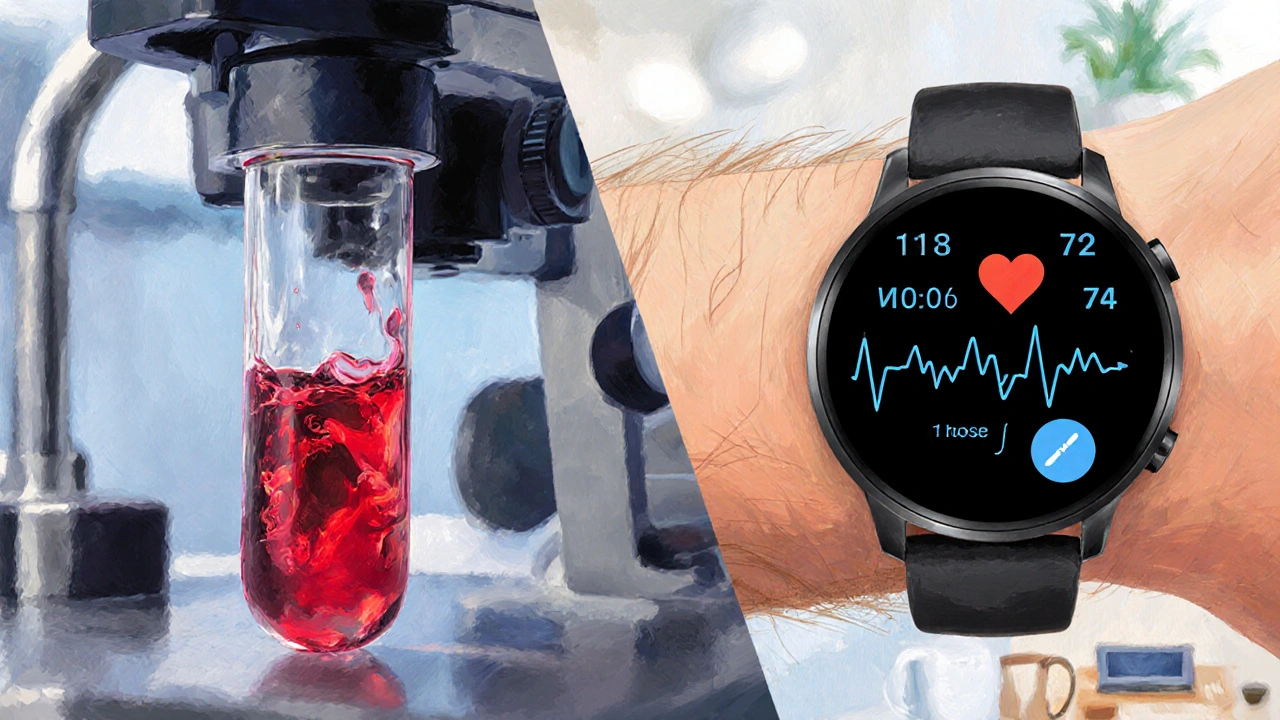Coumadin vs DOACs Comparison Tool
Choose your situation to compare options:
When you or a loved one need a blood thinner, the first name that often pops up is Warfarin a vitamin K antagonist that has been used for over 60 years to prevent clots. But the market now offers several newer pills that promise fewer lab visits and fewer food restrictions. The biggest question patients ask is Warfarin versus DOACs. This guide breaks down how Coumadin stacks up against the most common alternatives, so you can decide which profile fits your lifestyle and health needs.
TL;DR - Quick Takeaways
- Warfarin requires frequent INR checks and strict diet monitoring, but it’s cheap and reversible.
- Direct oral anticoagulants (DOACs) such as apixaban, rivaroxaban, dabigatran and edoxaban need no routine lab work, yet they cost more.
- Heparin and low‑molecular‑weight heparin (LMWH) are injectable, used mainly in hospitals or bridging therapy.
- Aspirin works for low‑risk prevention but offers weaker clot protection.
- Kidney function, drug interactions, and insurance coverage often dictate the best choice.
How Warfarin Works and What Makes It Unique
Warfarin blocks the recycling of vitaminK, a co‑factor needed to produce clotting proteins (II, VII, IX, X). Because the liver needs time to clear existing clotting factors, the drug reaches a steady state after about 3‑5 days. That lag is why doctors monitor the International Normalized Ratio (INR) to keep blood‑thinness in a therapeutic range, usually 2.0-3.0 for most indications.
Key attributes of Warfarin:
- Onset: 48‑72hours
- Half‑life: 20‑60hours, depending on genetics
- Reversal: VitaminK, fresh frozen plasma, or prothrombin complex concentrate
- Cost: Generally <$5 per month in Canada
- Interactions: Over 100 drugs, plus leafy greens can raise INR
Because of its broad experience, many clinicians trust Warfarin for patients with mechanical heart valves or severe kidney disease, where DOAC data are limited.
Direct Oral Anticoagulants (DOACs) - The Modern Alternatives
DOACs target specific clotting factors, delivering predictable anticoagulation without routine monitoring. Below are the four FDA‑approved agents commonly used in Canada.
Apixaban a factorXa inhibitor taken twice daily, approved for atrial fibrillation and venous thromboembolism (VTE) prevention
Rivaroxaban another factorXa inhibitor, usually dosed once daily, covering atrial fibrillation, VTE treatment and prophylaxis after hip/knee surgery
Dabigatran a direct thrombin (factorIIa) inhibitor taken twice daily, useful for stroke prevention in non‑valvular atrial fibrillation
Edoxaban a factorXa inhibitor approved for VTE treatment and atrial fibrillation, taken once daily
All DOACs share these advantages:
- No routine INR monitoring
- Predictable dosing schedules
- Fewer food‑drug interactions
- Rapid onset (2‑4hours) and relatively short half‑lives
However, they are pricier, and reversal agents are either limited or costly (e.g., idarucizumab for dabigatran, and andexanet alfa for factorXa inhibitors).
Injectable Options: Heparin and Low‑Molecular‑Weight Heparin (LMWH)
When immediate anticoagulation is needed-such as during surgery or in the intensive care unit-clinicians turn to Heparin an unfractionated anticoagulant given intravenously or subcutaneously, acting via antithrombin. Heparin’s effect is measured with activated partial thromboplastin time (aPTT) and can be reversed quickly with protamine.
For outpatient bridging or prophylaxis, Low Molecular Weight Heparin (LMWH) such as enoxaparin, offers predictable pharmacokinetics and is given once or twice daily subcutaneously. LMWH does not require lab monitoring in most patients, but dose adjustment is needed for severe renal impairment.
When Simpler Is Enough: Aspirin
Aspirin an irreversible cyclo‑oxygenase inhibitor that reduces platelet aggregation, used for primary prevention in low‑risk adults
While aspirin cuts the risk of a first heart attack, its clot‑prevention power is far weaker than the anticoagulants above. It’s also associated with gastrointestinal bleeding, especially at higher doses.

Side‑by‑Side Comparison
| Attribute | Warfarin (Coumadin) | Apixaban | Rivaroxaban | Dabigatran | Edoxaban | Heparin (IV) | LMWH (e.g., Enoxaparin) |
|---|---|---|---|---|---|---|---|
| Mechanism | VitaminK antagonist | FactorXa inhibitor | FactorXa inhibitor | Direct thrombin inhibitor | FactorXa inhibitor | Antithrombin activator | Antithrombin activator (low‑MW) |
| Typical dosing | 5‑10mg daily (adjusted) | 5mg twice daily | 20mg once daily | 150mg twice daily | 60mg once daily | IV infusion, weight‑based | 1mg/kg once or twice daily |
| Onset of action | 48‑72h | 2‑4h | 2‑4h | 2‑3h | 2‑4h | Immediate | 4‑6h |
| Monitoring needed | INR 2‑3 | No routine | No routine | No routine | No routine | aPTT | Usually none |
| Reversal | VitaminK, PCC | Andexanet alfa (limited) | Andexanet alfa (limited) | Idarucizumab | Andexanet alfa (limited) | Protamine | Protamine (partial) |
| Renal dosing | None (but monitor if severe) | CrCl <15mL/min - avoid | CrCl <15mL/min - avoid | CrCl <30mL/min - dose‑reduce | CrCl <15mL/min - avoid | Adjust if CrCl <30mL/min | Adjust if CrCl <30mL/min |
| Cost (CAD per month*) | ~$5 | $120‑$150 | $110‑$130 | $130‑$150 | $115‑$135 | Variable, generally $50‑$80 for inpatient | $70‑$90 |
*Prices are approximate retail costs in 2025; many provincial drug plans cover a portion of DOAC expenses.
Choosing the Right Anticoagulant - Decision Factors
Here’s a quick checklist you can run through with your clinician:
- Indication: Mechanical heart valve, atrial fibrillation, VTE treatment, or prophylaxis after surgery?
- Kidney function: Creatinine clearance below 30mL/min pushes you toward Warfarin or dose‑adjusted LMWH.
- Bleeding risk: Prior GI bleed may favor a factorXa inhibitor with lower GI bleeding rates (apixaban) over dabigatran.
- Drug interactions: If you’re on many meds (e.g., antibiotics, anti‑seizure drugs), Warfarin’s INR can swing dramatically.
- Lifestyle: Frequent travel or erratic meal times make a drug without dietary restrictions appealing.
- Cost & coverage: Check your provincial formulary; Warfarin stays cheap, but some plans now fully reimburse certain DOACs for seniors.
For most otherwise healthy adults with non‑valvular atrial fibrillation, a DOAC-especially apixaban-offers the best balance of efficacy and safety. For patients with prosthetic valves or severe renal impairment, Warfarin remains the go‑to.
Monitoring, Diet & Lifestyle Tips
Even if you pick a DOAC, keep an eye on kidney labs every 6‑12months. For Warfarin, download an INR tracking app and aim for consistent vitaminK intake: a handful of kale daily is fine as long as you don’t swing between zero and a lot of leafy greens.
Alcohol can boost bleeding risk across all agents, so moderation is key. If you’re on aspirin plus a blood thinner, discuss with your doctor; the combination raises bleeding odds noticeably.
What to Do If You Miss a Dose
- Warfarin: Take the missed tablet as soon as you remember, then continue with the regular schedule. No double‑dose.
- DOACs: If less than 12hours have passed, take the missed dose; if more, skip it and resume the next scheduled dose.
- Heparin/LMWH: Contact your clinic-missed injections can compromise therapeutic levels.
Bottom Line
There’s no one‑size‑fits‑all answer. Warfarin’s long track record, low price, and reversibility make it an excellent choice for certain high‑risk groups. DOACs win on convenience, fewer diet restrictions, and a lower overall bleeding profile for most patients. Injectables fill the niche of rapid‑onset, hospital‑based therapy, while aspirin remains a modest option for low‑risk primary prevention.
The smartest move is a personalized discussion with your healthcare team, weighing these factors against your medical history, budget, and daily routine.
Frequently Asked Questions
Can I switch from Warfarin to a DOAC overnight?
Usually you can stop Warfarin once your INR falls below 2.0 and start the DOAC the same day. Your doctor will schedule a final INR check to be safe.
What if I have kidney disease?
Mild to moderate kidney impairment (CrCl 30‑50mL/min) often allows a reduced DOAC dose. Severe impairment (CrCl <30mL/min) generally pushes you toward Warfarin or dose‑adjusted LMWH.
Is there an antidote for all DOACs?
Idarucizumab reverses dabigatran. Andexanet alfa works for apixaban, rivaroxaban and edoxaban but is expensive and not always stocked. VitaminK still reverses Warfarin.
Do DOACs require any dietary changes?
No strict restrictions. A balanced diet is fine; just avoid excessive alcohol, which can increase bleeding risk for any anticoagulant.
Which anticoagulant has the lowest risk of stroke in atrial fibrillation?
Large trials show apixaban and dabigatran slightly outperform warfarin for stroke prevention, with apixaban also showing less major bleeding.







